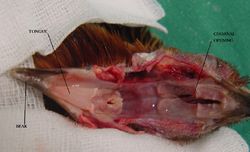Difference between revisions of "Avian Tongue - Anatomy & Physiology"
(→Links) |
|||
| Line 18: | Line 18: | ||
==Links== | ==Links== | ||
| − | |||
| − | |||
'''Click here for [[Tongue - Anatomy & Physiology|tongue - Anatomy & Physiology]]'''. | '''Click here for [[Tongue - Anatomy & Physiology|tongue - Anatomy & Physiology]]'''. | ||
| + | {{Template:Learning | ||
| + | |flashcards = [[The Avian Alimentary Tract - Anatomy & Physiology - Flashcards|Avian Alimentary Tract]] | ||
| + | }} | ||
[[Category:Avian Alimentary System - Anatomy & Physiology]] | [[Category:Avian Alimentary System - Anatomy & Physiology]] | ||
[[Category:A&P Done]] | [[Category:A&P Done]] | ||
Revision as of 14:57, 23 May 2011
Overview
The size and structure of the avian tongue varies between species. It is related to functional requirements.
Structure and Function
The avian tongue is narrow, pointed and contains little intrinsic muscle. The enteroglossal bone is present consisting of bone and cartilage with medullary spaces containing red marrow. It is supported by the lingual process of the hyoid bone and rudimentary lingual muscles. It contains striated muscle fibres.
Histology
A few caudally directed horny papillae are present on the avian tongue. There is a thick stratified squamous epithelium. The tongue is keratinised and has mucoid glands, although has no taste buds. Lymphatic tissue is spread throughout the corium.
Species Differences
Parrots use their muscular tongue to lap water and to produce human sounds (see syrinx species differences).
Links
Click here for tongue - Anatomy & Physiology.
| Avian Tongue - Anatomy & Physiology Learning Resources | |
|---|---|
 Test your knowledge using flashcard type questions |
Avian Alimentary Tract |
